"Twas the night before
Christmas, and all through the house, Not a creature was stirring,
not even a mouse..."
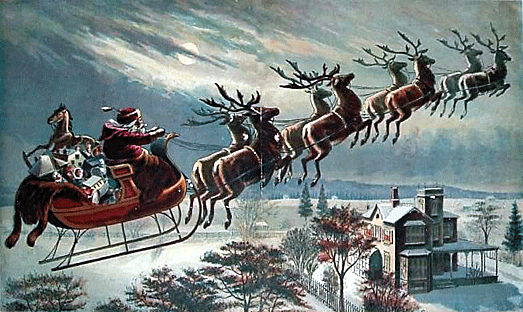
Thus begins one of the best-known and most beloved poems in the
English language and the most collected book in all of Christmas
literature. A truly American phenomenon, it has been published in
hundreds, perhaps even thousands, of different editions, in many
languages and in a multitude of formats since Clement Clarke Moore
first wrote it as a gift for his children on a snowy Christmas Eve
in 1822. Each year new editions appear as illustrators continue to
interpret the 56-line poem.
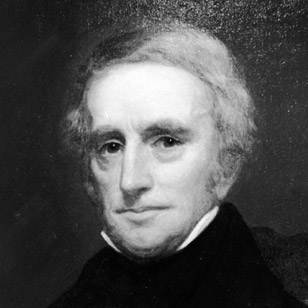 The
universal appeal to both young and old alike of “A Visit from Saint
Nicholas,” as Moore originally titled his poem, has made it an
indelible part of the anticipation, mystery, mystique and memories
that surround Santa Claus.
The
universal appeal to both young and old alike of “A Visit from Saint
Nicholas,” as Moore originally titled his poem, has made it an
indelible part of the anticipation, mystery, mystique and memories
that surround Santa Claus.
Moore’s poem first appeared anonymously in the December 23, 1823
edition of the Troy Sentinel in Troy, New York.
Legend has it that Moore had the inspiration for his poem as he was
returning home on a crisp, clear Christmas Eve afternoon in 1822.
The horse and sleigh with its tinkling bells and the snowy
countryside caused an idea to germinate in Moore's fertile
imagination. When he arrived home, he sat in front of the warm fire
with his many children scampering around excitedly, for this was
that special night when St. Nicholas would come to visit.
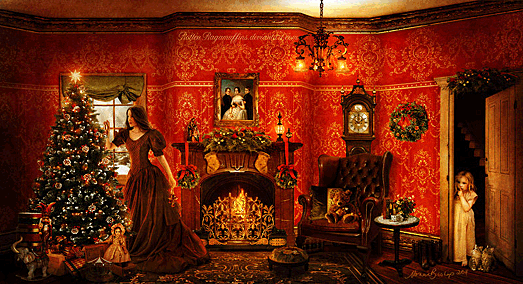
After dinner, Moore excused himself and went to his study, saying he
didn’t want to be disturbed, but that he would return before the
children were put to bed to present to them a surprise gift. He
emerged several hours later, and the entire family sat entranced as
he began to read: “was the night before Christmas, when all through
the house..." With those words, Moore unknowingly created an
enchanting Christmas ritual for children throughout the world.
While best known for his poem, Moore was also a well-known and
respected scholar of Hebrew and Greek. A scholar at the time would
have published works on a wide variety of topics including religion,
languages, politics and poetry.
For most of his life, Moore felt that his scholarly works had been
upstaged by what he considered a frivolous poem. In 1844, more than
two decades after he wrote "A Visit From Saint Nicholas," he
commissioned Bartlett & Welford to privately publish his Poems,
which included for the first time his admission to its authorship.
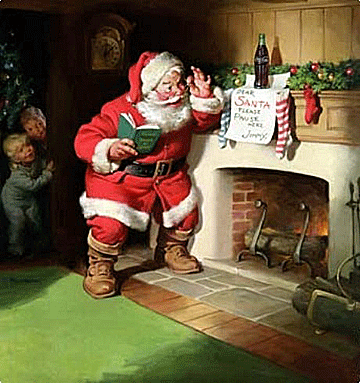 Through
his creative poem, Moore added original contributions to the
iconography of our present conception of St. Nicholas—the sleigh,
the eight reindeer, Santa’s fur clothing pipe, and his way of
entering and exiting via the chimney instead of using a door. A few
mid- to late-19th century illustrators reverted to the door,
including Moore's own daughter, Mary Clarke Moore Ogden, who
produced a very lovely color calligraphic illustrated edition of the
poem in 1855 as a Christmas gift for her husband. Kept in a bank
vault, Ogden's original manuscript is still held by Moore
descendants and taken out for family viewing only on special
occasions.
Through
his creative poem, Moore added original contributions to the
iconography of our present conception of St. Nicholas—the sleigh,
the eight reindeer, Santa’s fur clothing pipe, and his way of
entering and exiting via the chimney instead of using a door. A few
mid- to late-19th century illustrators reverted to the door,
including Moore's own daughter, Mary Clarke Moore Ogden, who
produced a very lovely color calligraphic illustrated edition of the
poem in 1855 as a Christmas gift for her husband. Kept in a bank
vault, Ogden's original manuscript is still held by Moore
descendants and taken out for family viewing only on special
occasions.
Over the years artists have depicted St. Nick as fat or thin, short
or tall, jolly or stern. Although Clement Clarke Moore forever will
be remembered as the person who truly gave St. Nicholas to the
world, it took Thomas Nast, with his famous etching in the Jan. 1,
1881 issue of Harper's Weekly, to portray Santa as we know and love
him today.
Illustrators, both famous and not-so-famous, have interpreted the
poem over the years and even to be works of art in typography and
binding, such as a 1930 edition of A Visit from St. Nicholas printed
and bound by the C.J. Krehbiel Co. of Cincinnati, on handmade paper
with linen-like paper-covered boards adorned with starbursts in
muted shades of blue, gray and taupe.
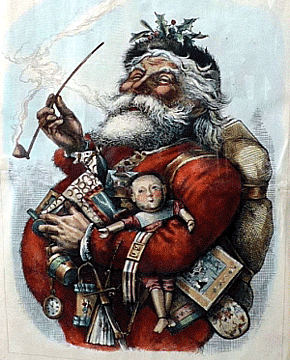 Some
of the 20th century's greatest artists, including W.W. Denslow in
1902, Jessie Willcox Smith in 1912, Frances Brundage in 1927,
Elizabeth MacKinstry in 1928, Arthur Rackham in 1931, Fern Bisel
Peat in 1932, Grandma Moses in 1948, and Tasha Tudor in
1962,1975,1999 have illustrated editions of “The Night Before
Christmas.”
Some
of the 20th century's greatest artists, including W.W. Denslow in
1902, Jessie Willcox Smith in 1912, Frances Brundage in 1927,
Elizabeth MacKinstry in 1928, Arthur Rackham in 1931, Fern Bisel
Peat in 1932, Grandma Moses in 1948, and Tasha Tudor in
1962,1975,1999 have illustrated editions of “The Night Before
Christmas.”
MacKinstry portrayed Santa with 12 reindeer instead of the eight
envisioned by Moore. The list of noted 19th century illustrators to
render the poem in published editions under a variety of titles
features William Croome (1840), Felix Octavius Carr Darley (1857),
Thomas Nast (circa 1870), E.F. Manning (circa 1890), and Virginia
Gerson, whose beautiful 1887 chromolithograph edition, A Visit from
Santa Claus, published by White Stokes & Allen in New York, is
difficult to find.
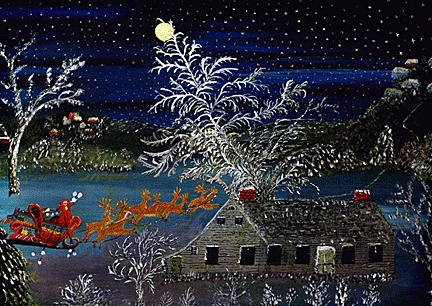 Editions
of the poem issued by private and small presses invariably are
elegant, appealing to the touch, and beautifully presented. They
possess a style that is difficult to attain in very large print
runs: gold paste down labels, pretty paper-covered boards, handmade
paper, and beautiful typography. Favored by collectors, this
category includes a 1937 Hawthorn House edition that features 16
lovely four-color stipple illustrations from linoleum blocks by
Valenti Angelo.
Editions
of the poem issued by private and small presses invariably are
elegant, appealing to the touch, and beautifully presented. They
possess a style that is difficult to attain in very large print
runs: gold paste down labels, pretty paper-covered boards, handmade
paper, and beautiful typography. Favored by collectors, this
category includes a 1937 Hawthorn House edition that features 16
lovely four-color stipple illustrations from linoleum blocks by
Valenti Angelo.
Other special renditions include a private printing in 1957 for the
Kings County Trust Co. with illustrations by the well-known artist
John dePol, a 1930 Haddon Craftsmen issue, designed by Arthur W.
Rushmore and printed for George A. Zabriskie, and an edition limited
to 300 copies illustrated by Hertha Sladky and sent as Christmas
cards in 1948 by Louise and Johnfritz Achelis of Vienna. A 1988
edition limited to 200 copies, printed at the Ascensius Press in
Portland, Maine, with color etchings by Emily Wentworth, is pure
elegance. The accordion-style book's covers are deep-red linen
overboards and the hand-made paper is an ideal medium for the
etchings.
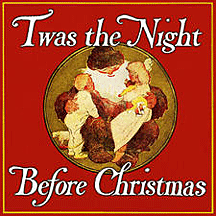 Miniature
editions, defined as those less than three inches in both height and
width, brighten any collection. Included in this category is Jane
Bernier's A Visit from St. Nicholas in Winterport, Maine: Borrower's
Press, 1980). Less than an inch in size, with 32 pages printed on
rag paper with many hand-colored illustrations, it was published in
an edition limited to 350 copies. Barbara J. Raheb's The Night
Before Christmas (Agoura Hills, Calif.: Pennyweight Press, 1992),
also less than an inch in size, is bound in green calf with the
title in gilt and marbled end papers; it was printed in a limited
edition of 300 copies. An inexpensive reprint of a 1870s edition
published by the Charles E. Graham Co. measures 1 by 1 in and is a
delicate but affordable facsimile of a magnificent original.
Miniature
editions, defined as those less than three inches in both height and
width, brighten any collection. Included in this category is Jane
Bernier's A Visit from St. Nicholas in Winterport, Maine: Borrower's
Press, 1980). Less than an inch in size, with 32 pages printed on
rag paper with many hand-colored illustrations, it was published in
an edition limited to 350 copies. Barbara J. Raheb's The Night
Before Christmas (Agoura Hills, Calif.: Pennyweight Press, 1992),
also less than an inch in size, is bound in green calf with the
title in gilt and marbled end papers; it was printed in a limited
edition of 300 copies. An inexpensive reprint of a 1870s edition
published by the Charles E. Graham Co. measures 1 by 1 in and is a
delicate but affordable facsimile of a magnificent original.
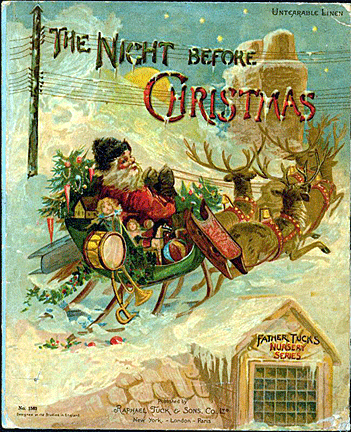 In
addition to traditional printed editions, the poem (or selected
words or phases) comes in a seemingly endless variety of formats:
postcards, View-Master reels, voice and musical recordings, puzzles,
mazes, broadsides, advent calendars, coloring and dot-to-dot books,
audio and video cassettes, films, piano rolls, doll-houses, paper
dolls, Christmas cards, Coca-Cola neckpieces, napkins, placemats,
ornaments, sheet music, games, 19th century almanacs, a miniature
Stetson hat box, children's and adult magazines, parodies and
anthologies. There are pop-ups and movables, punch-outs and put-togethers,
revolving pictures, hidden pictures, books within books, signed
English and Braille editions.
In
addition to traditional printed editions, the poem (or selected
words or phases) comes in a seemingly endless variety of formats:
postcards, View-Master reels, voice and musical recordings, puzzles,
mazes, broadsides, advent calendars, coloring and dot-to-dot books,
audio and video cassettes, films, piano rolls, doll-houses, paper
dolls, Christmas cards, Coca-Cola neckpieces, napkins, placemats,
ornaments, sheet music, games, 19th century almanacs, a miniature
Stetson hat box, children's and adult magazines, parodies and
anthologies. There are pop-ups and movables, punch-outs and put-togethers,
revolving pictures, hidden pictures, books within books, signed
English and Braille editions.
A copy of the poem written in Moore's own hand in 1860 sold it a
December 1994 auction at Christie's in New York for ;255,000, a
world auction record for an American literary manuscript at the
time. This same manuscript went up for sale, again at Christie's, in
December 1997 and sold for $211,500. Subsequently, Neiman Marcus had
it on consignment in its December 1999 Christmas Catalog for
$795,000. There were no takers, not even among the many dedicated
collectors of Moore's poem. This copy is still owned by the 1997
purchaser, Kaller's America Gallery of New York City, and is the
only one in private hands of the four authentic manuscript copies
known to exist. The Henry E. Huntington Library and Art Gallery in
San Marino, California, the Strong Museum in Rochester, New York,
and the New York Historical Society each hold one of the other
three.
